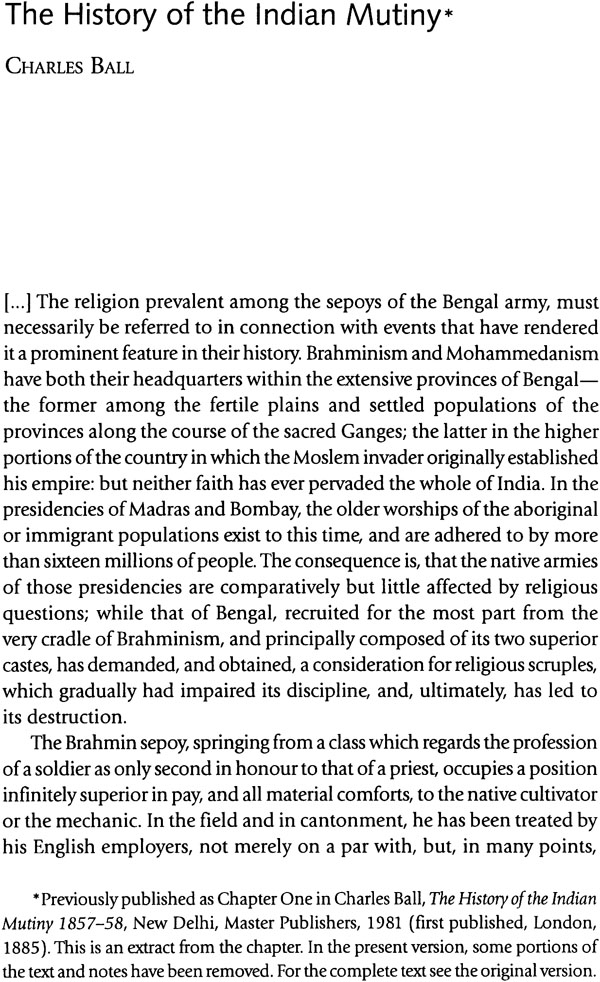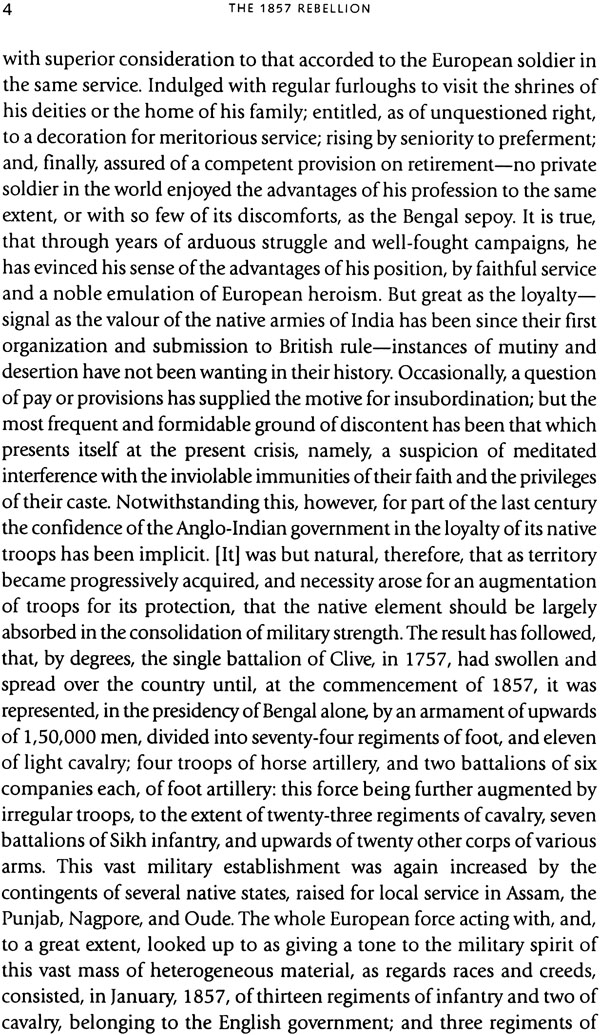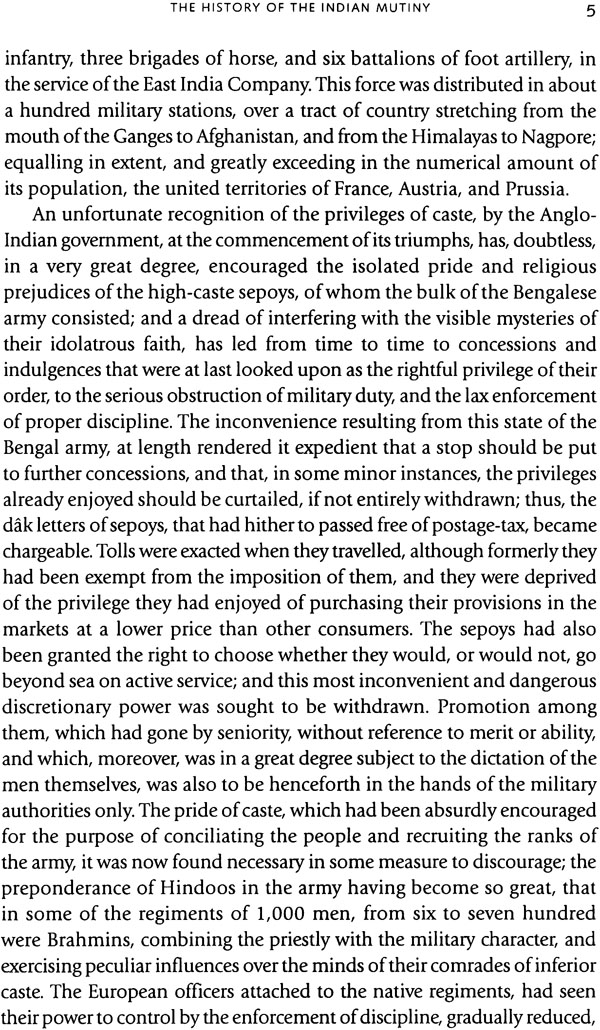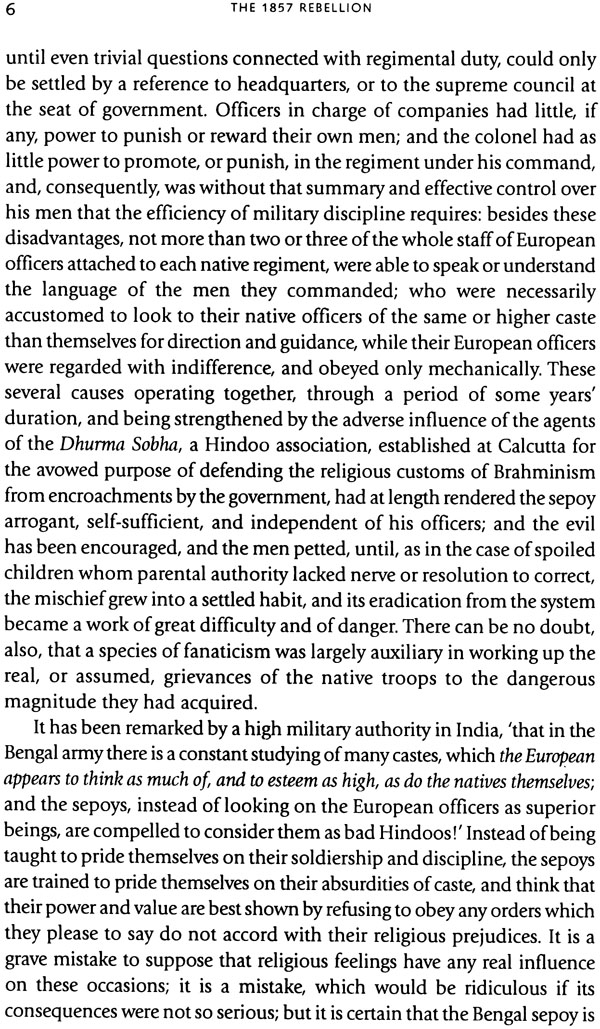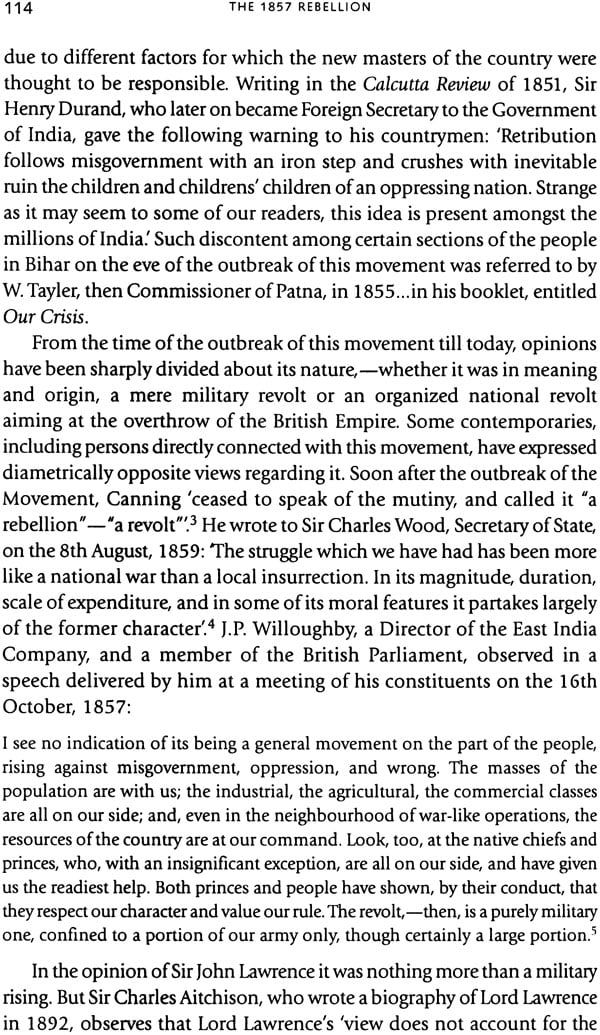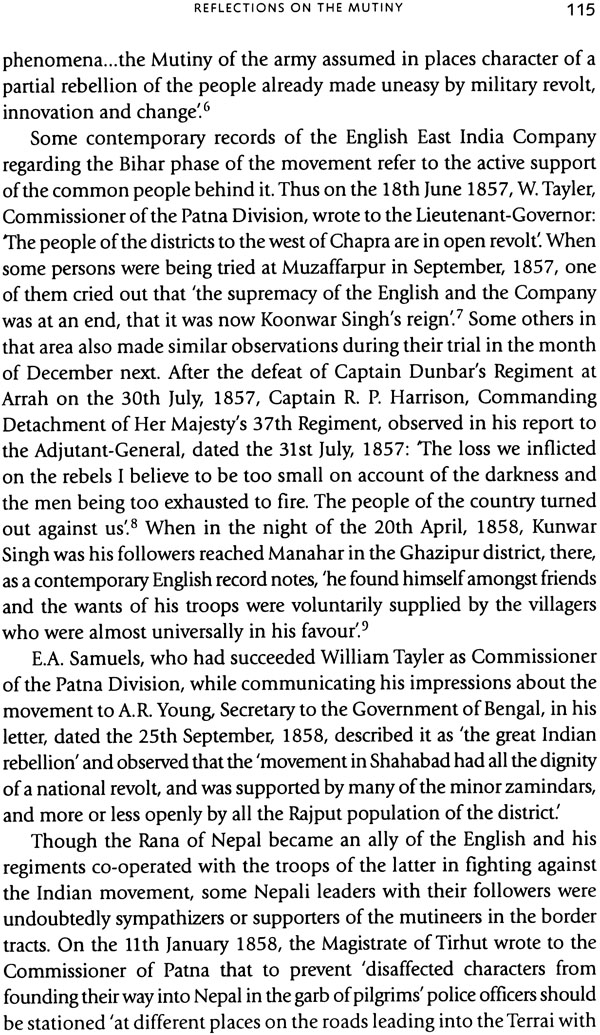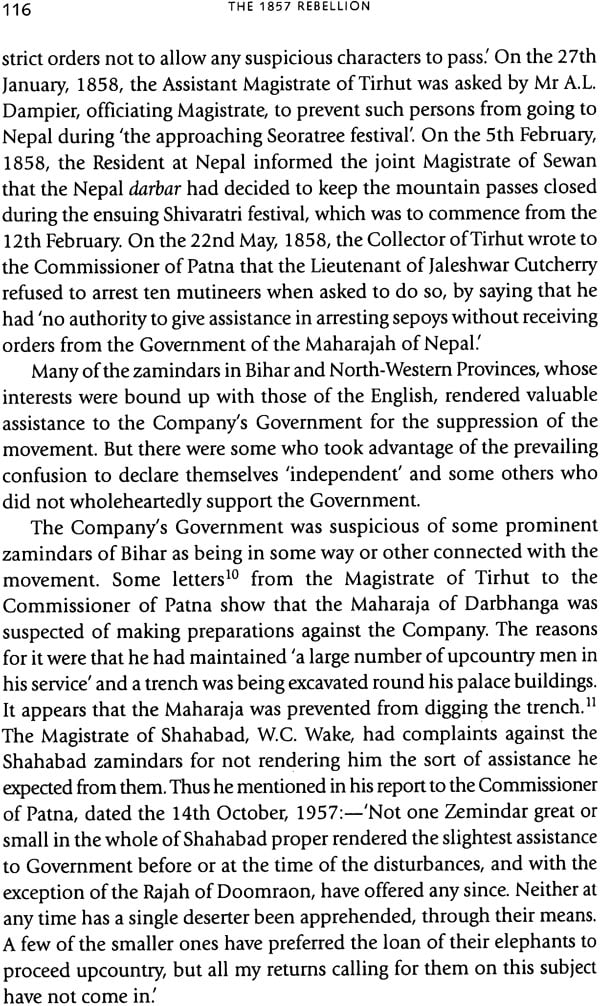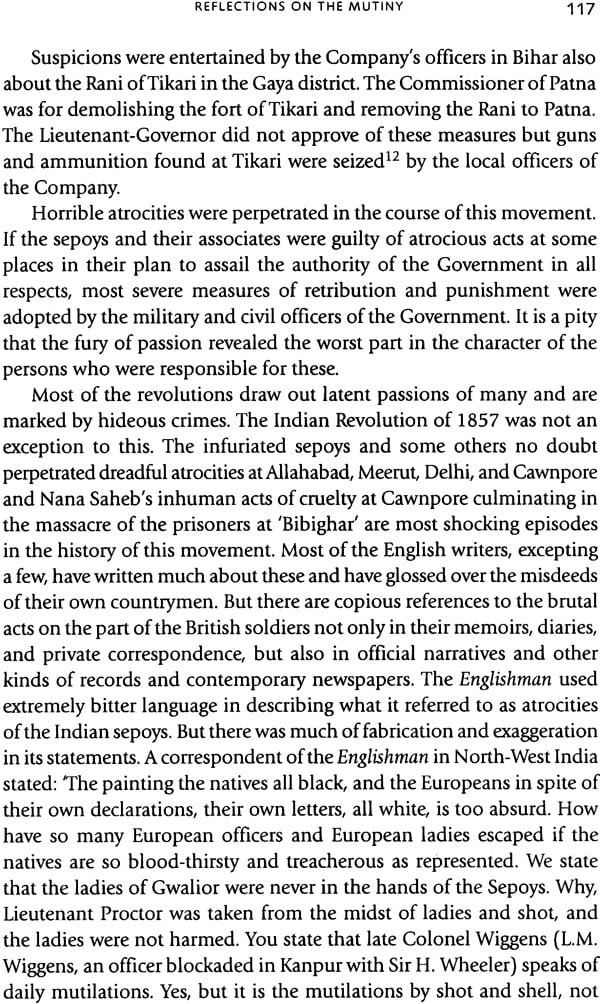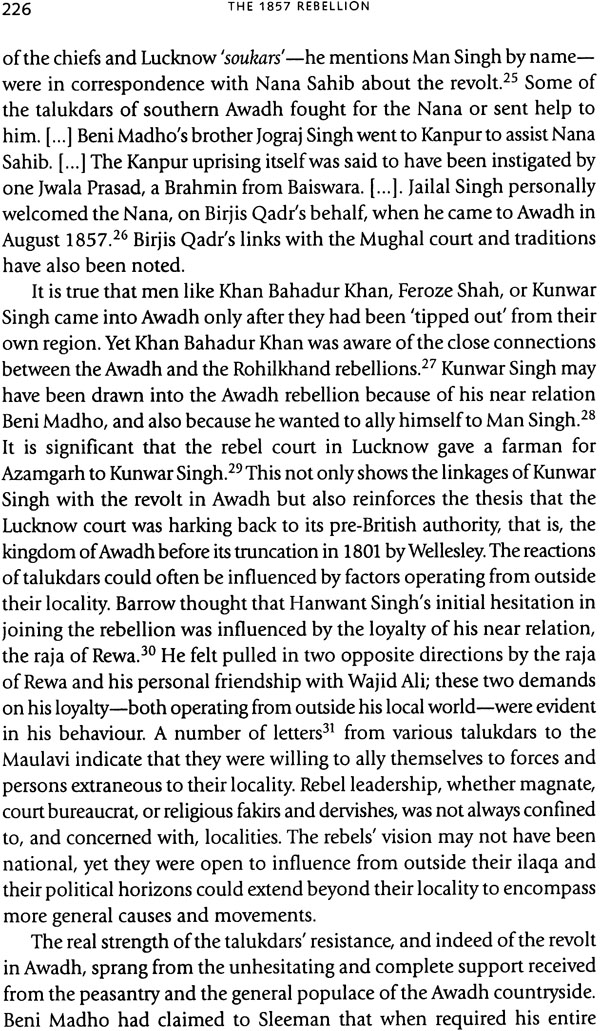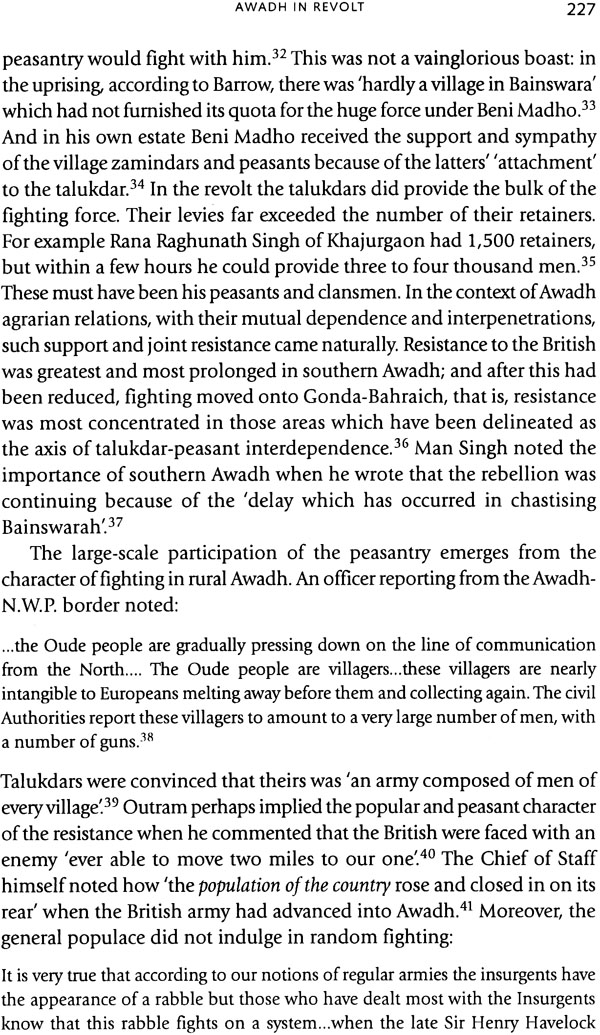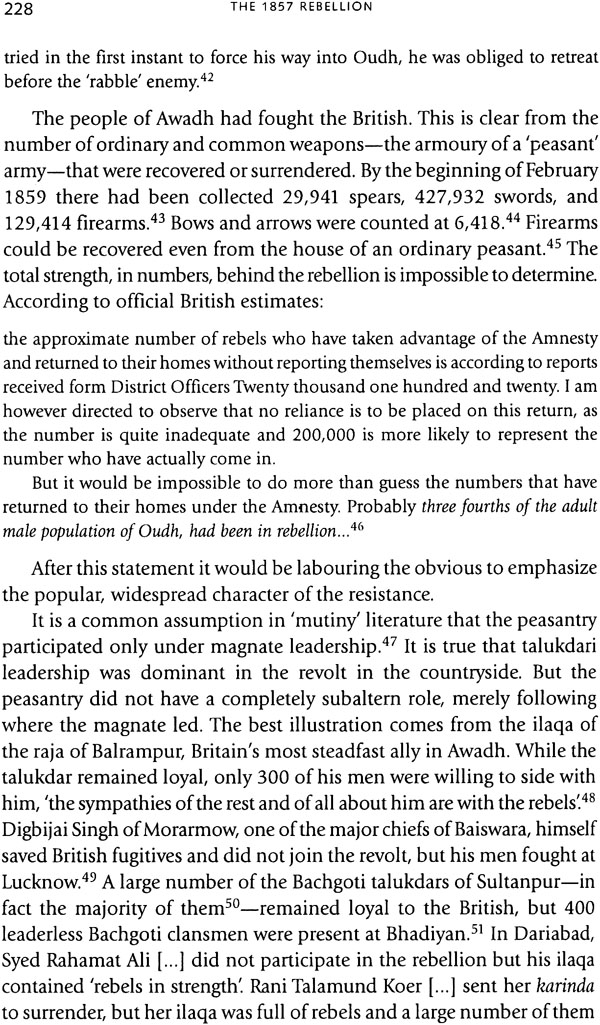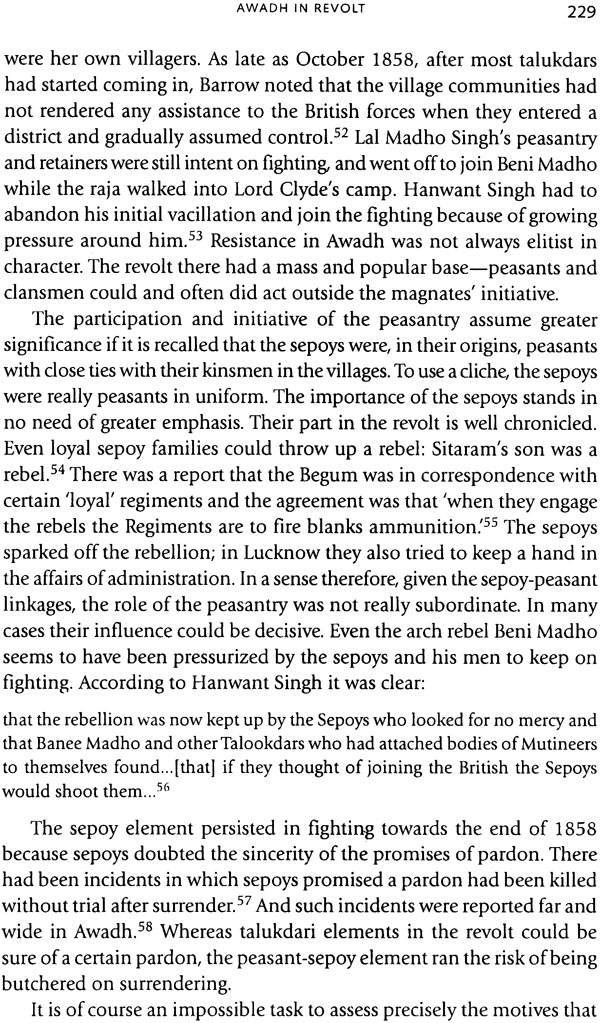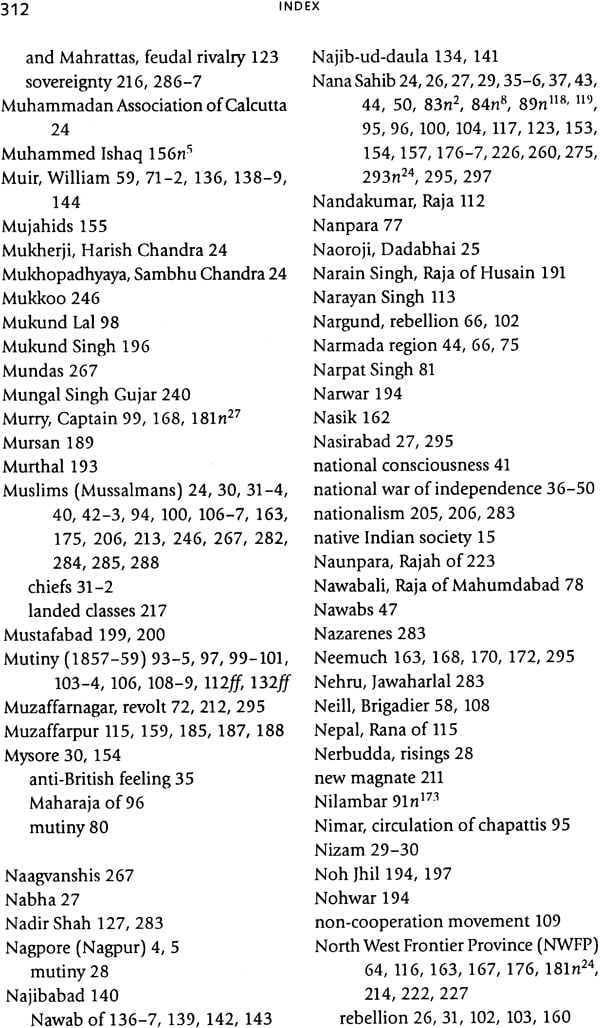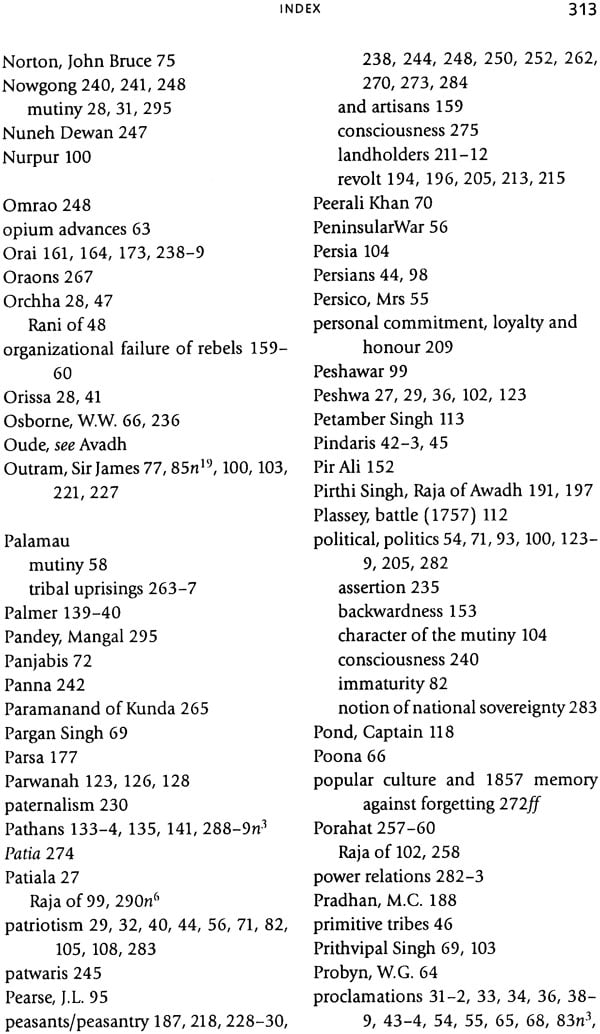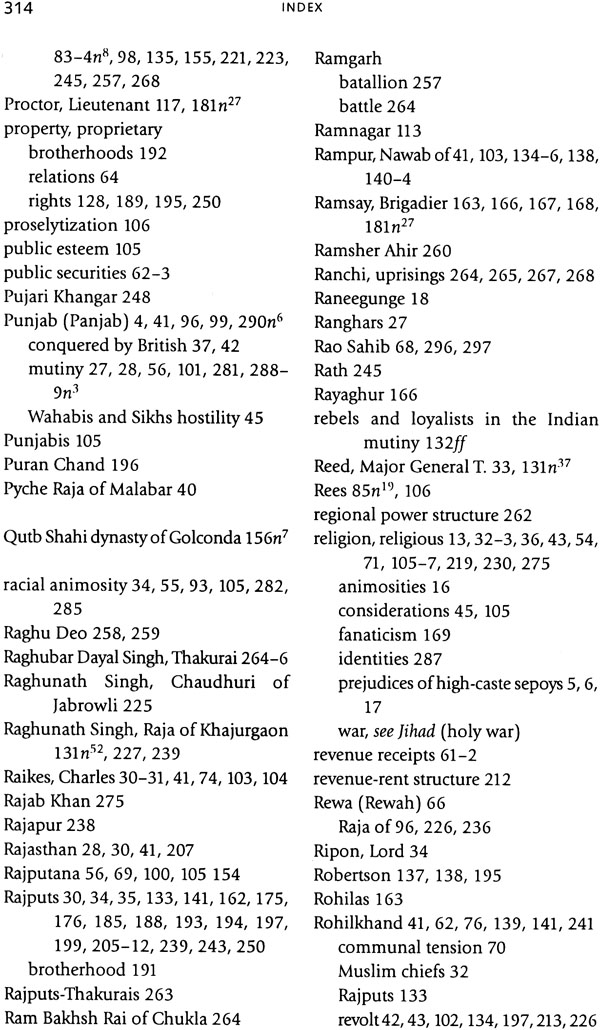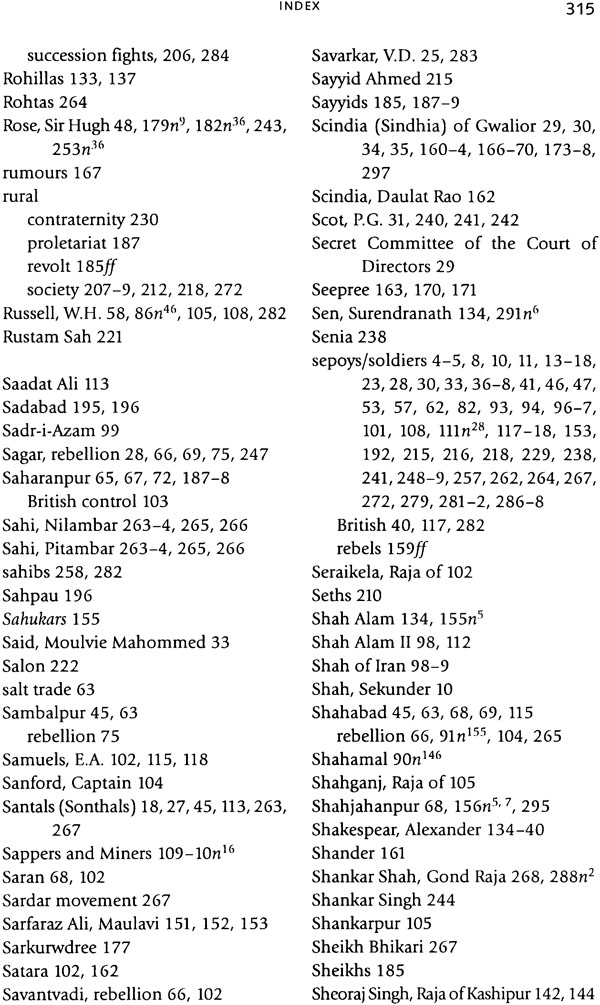
The 1857 Rebellion (Debates in Indian History and Society)
Book Specification
| Item Code: | NAF269 |
| Author: | Biswamoy Pati |
| Publisher: | Oxford University Press, New Delhi |
| Language: | English |
| Edition: | 2011 |
| ISBN: | 9780198069133 |
| Pages: | 366 |
| Cover: | Paperback |
| Other Details | 8.5 inch X 5.5 inch |
| Weight | 350 gm |
Book Description
The Debates in Indian history and society series focuses on the diversity of interpretation in historical discourse. The series address widely debated issues in south Asian history (Including contemporary history) through edited volumes centering around sharply focused themes or seminal writings that have generated arguments and counter arguments resulting in worthwhile debates. In this context the debated represent not simply differences in opinion but also offer important interpretative frameworks which result in them acquiring a certain historiography status. The approach encourages the interrogation of history as distinct from presenting history as a collection of given facts. The aim is to bring to readers significant writings interpretations and sources and to open to students bridge heads into research.
It is easy to see that in a series such as this on debates in history a volume on 1857 will be high on the agenda. The historians discourse in the crop of writings produced about the time of the centenary in 1957 centered around a controversy is it correct to characterize the uprising as a part of the nationalist movement earlier there was a controversy among British observers whether the uprising was the outcome of a conspiracy and was it caused mainly by the reaction to the introduction of greased cartridges for the Enfield riffle or deeper seated causes of disaffection in the Marxist historiography tradition the debate has been on the class character of the uprising was it a move towards a feudal restoration given its leadership or a part of the struggle of the peasantry primarily work form the subaltemist point of view have raised another question to what extent was the movement characterized by subaltern agency or autonomy in the light of recent recrudescence or religious fundamentalism the issue debated is again different was the uprising the nature of a religious was a link in the long history of confrontations sometimes described as a clash of civilization much provocative writer will be found in the following pages, but even those dissenting would probably agree about the utility of this collection of writing on the debates on 1857.
The 1857 rebellion was born out of historical processes ranging from the British policy of conquest and expansion to the colonial exploitation of India. If one goes by the colonial mapping of the rebellion it affected north western north and central India. However present day research shows that the rebellion also touched parts of the east and the south. If needs to be mentioned here that the nature of the 1857 rebellion has been debated from the time of the event itself. The basic idea of setting things in order to retain the emerging empire provided the rational to colonialist not only to ponder over what went wrong but also to asses the nature of this upheaval. It was perhaps this aspect which kept the rebellion alive for some time among the colonial administrators. Shifts in the way the nature of this upheaval. It was perhaps this aspect which kept the rebellion alive for some time among the colonial administrators. Shifts in the way the nature of 1857 was located were visible within the initial reactions and written about very soon as well. Whereas he logic of retaining the monopoly of the east India company defined 1857 as a sepoy Mutiny (or siphai as the company native soldier was called.) the idea related to wiping out the needed immediate attention the sheer diversity of interpretations even among contemporaries crates an apparent problem of labeling or categorizing them into a simple set of opinions emanating from any specific geographical part of world.
The sepoy Mutiny as it was labeled initially by most members of the master race in India not only challenged colonialism but also forced it to re invent itself to face a future that seemed uncertain and full of major challenges. Those who focuses on the Mutiny theme saw it as the handiwork of a set of discontented sipahis who were unhappy with the introduction in 1857 of the enfield riffle its distinct ammunition which required the bullet to be bitten before loading rumours that the grease used on the bullets was from the fat of cattle or pigs had deeper symbolic implications since cows were considred sacred by the Hindus while the Muslim considered pigs to be pulling. This created strong animosities and was perceived as an attack on Hindu and Muslim religious beliefs.
Disraeli representing a new generation of imperialists anxious about losing the fact emerging crown jewel of the British empire pointed our such result are occasioned by adequate causes and by an accumulation of adequate causes. For him the causes of the uprising lay not so much in the conduct of men who were the exponents of general discontent amongst the Bengal army as in the overall administration by the government which had alienated or alarmed almost every influential class in the country interestingly in December 1857 Major Williams who was the commissioner of the military police, North Western provinces described 1857 as the great national insurrection in India.
Contemporary officials located 1857 as a Hindu upper caste conspiracy which shifted to that of a Muslim conspiracy. This stabilized as a part of their commonsense. Syed Ahmad Khan (1817-1898) wrote a tract (Asbab-e-Baghawat-e-Hindi, 1857) where he sought to examine the underlying features that determined the nature of 1857. This effort is sometimes highlighted by historian to show that Khan countered the argument that located 1857 as a Muslim conspiracy. Nevertheless what is not properly highlighted is that S.A. Khan was perhaps the first Indian viewpoint that located 1857 as a rebellion ad critiqued imperialism and its policies in order to explain the causes of the Rebellion what is normally remembered is Khan later tract (originally in Urdu; 1860) which focused on the loyal mulims.
Contemporary writings generated political hysteria and racism. Some accounts of eye-witnesses in fact inscribed invention like the rape of white women during the Mutiny these not only reinforced the barbaric image of the Indian but also kept alive the need for retaining the civilizing mission and providing legitimacy to colonial rule. It is striking that Charles dickens who was a major chronicler of the English working class adopted a virtually condemnatory attitude vis-à-vis the rebellion. In fact his racist stereotyping of all colonized peoples of Africa the Indian Americans and all other natives was also shaped by a complex set of factors conditioning responses to the rebellion in England.
The 1857 rebellion demonstrated the way English opinion was divided at home. Thus chartists like Ernest Jones hailed the rebellion and unmasked the colonial exploitation of India. The most serious dissenting voice was that of Karl Marx who linked the colonial exploitation of India to the anger displayed by the people during the rebellion. As he put it: the profound hypocrisy and inherent barbarism of bourgeois civilization lies unveiled before our eyes turning from its home, where is assumes respectable forms to the colonies where it goes naked. Did they not in India to borrow an expression of that great robber, Lord Clive himself resort to atrocious extortion when simple corruption could not keep pace with their rapacity? While they parted in Europe about the inviolable sanctity of the national debt did they not confiscate in India the dividends of the rajahs who had invested their private savings in the company own funds these are the men of property order family and religion marx and Engels hailed the unity shown by the different religious communities opposed to British colonialism.
Given its social composition the Indian national congress denounced the 1857 rebellion after its formation in 1885 by the end of the nineteenth century however the rebellion attracted and inspired the first generation of Indian nationalist the early nationalist were guided by the position of some colonial official who as outlined earlier saw it as a national insurrection. With the development of Indian nationalism the rebellion was incorporated and appropriated as a part of the nationalist imagery. Thus V.D. savarkar the first Indian to write about the rebellion form a nationalist position in 1909 called it the Indian war of independence. His pro nationalist stance made savarka look with contempt at the British assertion of the greased bullets as sparking the war and reject it. He argued if this had been the issue it would be difficult to explain how the rebellion could attract Nana Sahib the emperor of Delhi the Queen of Jhansi and Khan Bahadur Khan to joint it. Besides he also highlighted the fact that the rebellion continued even after the English governor bullets. Savarkar went ahead and connected the rebellion to the atrocities commented by the British. This factor of unity cutting across religions boundaries in fact makes his argument striking and goes against the subsequent shift in his position that saw him accommodate the Hindu Muslim divide as a virtual fault line in India history consequently the early nationalist described 1857 as a rebellion through which the Indian opposed the suffering and exploitation imposed on them by British colonialism.
With the development of the working class movement in India efforts were made to analyse the 1857 rebellion form a Marxist position by pioneers like M.N. Roy and Rajni Palme Dutt. Roy was rather dismissive of 1857 and saw in its failure the shattering of the last vestiges of feudal power. He was emphatic about the revolution of 1857 being struggle between the worn out feudal system and the newly introduced commercial capitalism that aimed to achieve political supremacy. In contrast Palme Dutt saw 1857 as a major peasant revolt even though it had been led by the decaying feudal forces fighting to get back their privileges and turn the tide of foreign domination consequently one witnesses the beginnings of a process that interrogated and critiqued the internal feudal order even while lauding the popular basis of the rebellion.
The access to official records and archival sources since independence saw interesting developments related to debates on the nature of 1857. A rather sophisticated nationalist historiography that look cognizance of the complexities of the rebellion evolved in the process. It included nationalists historians like R.C. Majumdar historiography that took cognizance of the complexities of the rebellion evolved in the process. It included nationalist historians like R.C. Majumdar S.B. Chaudhuri S. N. Sen and K.K. Datta who were not uniformly comfortable with the idea that the 1857 rebellion was the first war sponsored by the state and his authoritative official post colonial account of 1857 obviously had an agenda of celebrating Indian nationalism. In fact the spirit of the Indian national movement left its deep imprints on these historians. This meant that some of them referred to ideas like nationalism supposedly witnessed during the rebellion or saw the very inception of the national movement contained in the 1857 rebellion. They went very clearly beyond the simple categorizations that had seen tow dominant and opposing narratives lauding the British the victors who had won the war and the claims of the rebellious Indian who had been defeated. This menat a shift to understanding the internal contradictions (viz. the Indian rich, which included the moneylenders and buniyas) and the popular basis of 1857. These views did not concentrate merely on influential classes like the explanations provided by contemporary British officials or statesmen like Disraeli. It is here that nationalists historiography worked on and developed the legacy of the Marxists even as some historians disapproved of labellings the rebellions as the first war of Independence. In this sense at least nationalist historiography threatened to transgress the boundaries imposed on it by the early nationalist. The nationalists historians also accorded a space howsoever limited to the popular basis of the rebellion. They highlighted the mutiny component of 1857 the shifted and assumed the nature of a civil rebellion nationalist historiography therefore most certainly opened up new possibilities.
Since peasants did/do not write their histories their interaction with the rebellion remains undocumented. But is it possible to ignore the folklore issues related to moral economy and traditional of resistance the connection between 1857 rebellion? Moreover can one afford to ignore the connections between 1857 and the peasant revolts of the preceding phase or those outside the northern region of India? One can for example refer to the rebellions of the bhills in 1852 (in Khandesh Dhar and Malwa), the sandals in 1855-6 (in Rajmahal, Bhagalpur, Birbhum), the Mapilas over the 1836-54 period in Malabar the kandhas in ghumsar and Baudh (1855-60) the savaras of parliakhemedi (1856-7) in the same way the indigo revolt in Bengal (that began in 1859 and was directed against white planters) serves as an example inspite of our being repeatedly told that the permanent settlement and bhadroloks left Bengal as a zone of peace in this phase.
Unless one locates historical processes in a narrow factual manner it would be indeed almost impossible to assume that peasant cannot thinks or incorporate components from the past while struggling against colonial rule and their immediate oppressors. It is therefore difficult to study the rebellion without taking into account the social history of peasant protest prior to 1857 and in the ensuing period. This would bring out the complexity of issues and invert many commonly held positions associated with the rebellion including the point that colonialism was its virtual creator the over emphasis on related economic factors or a point that has almost got frozen as common indo-genetic plain.
With the passage of time the development of other historical approaches generated several debates on the nature of 1857. The first exhaustive work on the rebellion was published in 1957 to commemorate the hundredth anniversary of the event. Edited by P.C. joshi this was first attempt of Marxist historians to focus on the diversities and the specificities of the 1857 rebellion. The effort included assessing 1857 against the colonial backdrop examining aspects of participation and focusing in a major way on internal contradictions. Its significance lay in the use of urdu source and folk songs in many ways this work inspired a serious spell of writing on the rebellion. Issues ranging form the way the nature of 1857 was conditioned the role of the peasant especially the rich peasant to question related to its organization middle the rich peasant to questions related to its organizations middle level leadership activates in the areas where British authority had been subverted and whether it was indeed a restorative rebellion have attracted the attention of historians. It is the popular level of the rebellion that concerned Ranajit Guha and the subaltern historians. Guha highlighted features such as the colonial lebelling dacoit leaders and dacoit villages the targeting of European properties planters and factories colonial records as well as sahukaras and buniyas. Rudrangshu mukherjee and tapti roy took up specific area studies that have brought forth fascinating complexities of popular militancy that had earlier remained ignored.
More recently since the 1990s historians have focused on the popular dimension of 1857 including the specificities of the involvement of adivasis low castes and outcaste popular cultural and mentalities and question related to the alternative order that emerge. Present day scholars’ working within the paradigms of cultural studies have also sought to delineate the way racism emerged as a virtual fall out of the rebellion. By focusing on the rape of white women during the rebellion colonialist inscribed images of the barbaric Indian in the colonial imagination.
The 1857 rebellion represent possibly one of the most powerful and dramatic anti colonial movement that also questioned internal exploitation. The intricacies and contours of the rebellion have made it the subject of intense debate and interrogation especially the emergence of regional studies has added several new dimensions to the existing scholarship in the last two centuries the focus of the debates have shifted from the mutinous sepoys and seeing in it the origins of Indian nationalism to studying the internal contradictions the participation of the common people and the diversities of the rebellion. These feature reflect corresponding shifts in modern Indian historiography which have both influenced and been influenced by the way the nature of 1857 has been debated.’
Sepoy Mutiny
The Indian Mutiny of 1857 began with Indian or native soldiers in the Bengal army of the English east India company. The starting point of the characterization of the rebellion as a sepoy Mutiny can be traced to the official accounts of people like William Muir the secretary to the government of North Western provinces. For muir 1857 was a mutiny of troops a struggle between the government and its soldiers. These initial interpretations concentrated on the mutiny factors carefully disguising the problems created by the company rule. The political effort to retain control over India and the counterinsurgency operations directed against the mutineers made the colonial insurgency operations directed against the mutineers made the colonial officials perceive the discontent of the sepoys as the primacy factor in the debates. Interestingly the company method of emphasizing caste in its army and giving importance to the religious angle were both ably sustained by and in turn reinforced the greased cartridges theory while explaining the nature of the rebellion.
Charles ball and J.W. Kaye were among the pioneers who wrote about 1857 from the sepoy mutiny perspective. Both ball and kaye attached tremendous importance to caste status which the sipahis thought were undermined in the cantonment. Ball ascribes the undermining of the caste status of the siphais to stopping and curtailing of certain concessions. He cites factors like the loss of privileges charging the siphais for their dak that had previously been allowed without postage tax new tolls that were now levied on them when they travelled withdrawal of privileges when they bought their provision and the curbs on their right to choose their posting (viz. whether they would or would not cross the sea on active services) promotions earlier based on seniority and not on merit or ability and decided by the men themselves began now to be decided by military authorities. Being at the lower rungs of the army meant low salaries which left the siphais dissatisfied. These features asserted European supremacy and were irritant especially in a context wherein the few Europeans attached to the regiments did not speak or understand the language of the men they commanded.
Kaye underlines the importance of the greased cartridges which caused an alarm among the sipahis. The new enfiled bullets were coatd with grease made from the fat of cows (sacred to Hindus) and of pigs (anathema to Muslim). Since the cartridges had to be bitten before beings used the Hindu and muslim siphais interpreted it as part of a plot to force them to adopt Christianity. The native siphais believe that thorough the cartridges their Christian masters aimed to defile their caste and their religion. Both mention the dharma sabha in Calcutta (which they define as a body aimed to preserve Hinduism from the onslaught of the English) projecting the issue fo cartridges as a devise the cartridges as a devise aimed at forcing the sipahis to embrace Christianity. The British replaced the cartridges when the mistake was realize but suspicion persisted. In February 1857 began a series of incidents with siphis refusing to use cartridges.
In fact present day historians refer to the reforms of the 1830s which disturbed power relations that had bestowed financial security and a high religious and social status for the sipahis and their families. Their batta (viz. allowance) which they received during service in foreign lands was discontinued. Form the 1840s the sipahis were given permanent posting in distant military outposts of Sindh and Punjab located as foreign lands away from their families raising apprehensions about the violation of the caste status of the Hindu siphais. Coming to the immediate background of 1857 the idea of turning toward internal recruiters like kunwar singh. Nana Sahib, or the rani of Jhansi reflected a desire of the sipahis to get back their lost status.
Nationalist Uprising
India independence meant the availability of sources which was a great help for the nationalist historians. The pioneers in the field included R.C. Majumdar S.B. Chaudhuri S.N. Sen and K.K. Datta R.C. Majumdar while pointing to the mutiny rebellion of the people divide was critical of the contemporary bhadraloks like kishorichandra Mitra who wrote in 1858 that it was revolt of a lac of sepoys and some of the association (like the British Indian association and the Muhammadan association of Calcutta) that had passed resolution condemning the outbreak of the mutiny examining the nature of 1857 Majumdar notes the civil population revolting in the locality only after the withdrawal of British authority in a context when British authority had collapsed and there was a political vacuum emphasizing the absence of coordination of different groups and individual leaders to underline the absence of a common cause. Amjumdar also mentions the involvement of the goonda elements in 1857.
The widespread nature of the 1857 rebellion in northern India and the way it turned into a mass movement in eastern Punjab is significant for majumdar. Simultaneously he specifies awadh whre the rebellion seemed to be of a popular or national charcter due to particular local reasons since it was so arbitrarily annexed only a year before the mutiny discussing some of the major leaders of the rebellion like Bahadur Shah Nana Sahib, the Rani of Jhansi and Kunwar singh, he mentions the special grudge they had against the British although these leaders could also have been inspired by patriotism there was no evidence to support this aspect Majumdar also question the ideas that these leaders could also have been inspired by patriotism there was no evidence to support this aspect Majumdar also questions the idea that these four were natural leaders under whom the Indians fought the war of independence and the love for their country that determined the participation of the civil population.
Majumdar is particularly critical about the tendency to see the unity of Hindus and Muslims that was displayed during the rebellion. He cities the evidence of communal riots in parts of the United provinces where the Muslim shouted for the revival of the Muslim kingdom and the suspicion and jealously among the Muslim on the one hand and the Marahas and the Sikhs on the other Dismissing the idea of the rebellion beings a national war of independence he delves on the attempts by the local chiefs and talukdars to re assert their lost rights and argues that it was not possible to see nationalism or patriotism in 1857 or at any time before it. In the frontline areas of the rebellion like Rohilkhand and awadh independence from British control had been achieved by the sipahis and it was more a question of maintaining and achieved by the sipahis and it was more a question of maintaining and not gaining independence. This phase however was marred by subversive activities and infighting based on the interests of Individuals classes and states and the absence of patriotism among the people. He felt that the war of independence theme involving the civil population could be accepted only to explain the anti British component.
S.B. Chaudhuri emphasized the bifurcation of 1857 into two distinct historical aspects viz the military mutiny and the civil rebellion as a whereas the sipahis struck the first blow, they did not produces the leadership necessary to canalize the activities of the rebellious troops. This meant that some civil elements assumed the leadership of the movement necessary to canalize the activities of the rebellious troops. This meant that some civil elements assumed the leadership of the movement and turned it to their advantage. This toned down the military character of the revolt and saw the merging of the military rising into a popular rebellion. Chaudhuri referred to the religious and race components that marked 1857. Describing the popular basis of the rebellion he mentions the terror that was unleashed to suppress it. Chaudhuri analyses how the British government in India viewed 1857-8 as a vast upsurge of the people. He refers to various measure adopted to meet the crisis ranging from raising troops areas. Although he vies failure to re-establish its authority in several areas. Although he views the civil rebellion as mainly a talukdari movement he refer to the participation of different sections of the people including the low casts and cultivators.
1857 is both a mutiny and a rebellion for chaudhuri. People directed their wrath against their oppressors and targeted government offices records police stations telegraph poles, railway line, and engines interestingly he refers to areas like sharanpur where the houses of bonias were burnt along with their accounts books were carried out of the town and torn up on the highway. As discussed the mahajanas were on the side of the British. Factors owned by Europeans were destroyed and indigo factories targeted. Paradoxically some feudal sections (like some of the big native princes and chiefs) stayed out of a revolt that was very often characterized as feudal.
Significantly leaders did not remain confined to their areas but sought to mobilize the people in adjacent tracts. Well known leaders like the fyzabad maulavi firuz Shah, Tantia Tope, the Rani of Jhansi, Rao Sahib, and Kunwar Singh were visible in many fronts during the rebellion in upper India. Madho singh of bhognipur joined the rebels at lucknow mehndi Hasan of sultapur dominated the districts surrounding awadh and surrendered only when the rebellion was dying out. Some of the other leaders chaudhuri discusses are the plawer chief madhoparasad of Birhar, whose activities could be traced up to Azamgarh; and the sagar leader daulat singhs who swept through Jalaun, Jhansi, Hoshangabad and Rajputana. This effort to create solidarity transcended barried of caste religion and region and demonstrated a level of social brotherhood visible in different areas.
Chaudhuri is critical of colonial of official who refused to acknowledge the conversion of the mutiny into a rebellion and considered it a mere mutiny of troops. Labeling of 1857 as a rebellion of the riff-raff is unfounded and weak. Disagreeing with majumdar that it was not the result of a conspiracy chaudhuri underlines its popular basis by referring to the background years of discontent and anger and focuses on awadh to illustrate his point. He speculates about the possible inception of the nationalist movement in the 1857 rebellion.
The organizational aspects of the rebellion have been examined by S.N. Sen. He points out the significance of the circulation of chappaties observed in parts of north India by many colonial officials in the preceding phase of the rebellion. Sen closely studies the letter supposedly written by Rani Laxmi Bai in March 1856 to her family priest at put. His method of questioning is authenticity (on the basis of the English style of dating the wrong seal used and the reference to greased cartridges which did not come to India before November 1856 and the Rani presumed presence in Meerut from where this letter was written since there is no evidence that she had ever been there) reflects the development in the historian craft over this phase in India. Sen it critical of arguments that saw the rebellion as a conspiracy in siphai any foreign power. According to him the rebellion originated in siphai discontent and them derived its strength from the widespread disaffection among the civil population.
Neither the entire non-european siphai component not all the people were behind the rebellion. A section of the sipahis fought for the government while some regions like the madras presidency remained largely unaffected. The strength of the rebellion was precisely because it was supported by people from diverse section ranging from the Sikhs in Delhi and tribesmen in the frontier the Bhills in Rajputana and Central India to the Pasis in Awadh. No community caste or class was entirely for or against the rebellion. For sen it united Hindus and muslim. He saw awadh as a region where the revolt assumed a national dimension. Emphasizing the need to be cautious he refers to the way the patriots fought for their king and country although they were not champions of freedom. He is critical of the leaders who would have set the clock back for the tenants in case the rebellion had been successful. Sen is dismissive of both the influence of religion on those who had joined in the rebellion and interpretations of a clash of civilization between barbarism and civilization. About the latter he emphasizes the logic of hatred and animosity based occasionally on rumours and mentioned the atrocities perpetuated on the common innocent people during the counter insurgency operation
Conspiracy Versus Organized Movement
The categorization of the nature of 1857 as a conspiracy can be traced to the time of the rebellion itself. In government circles 1857 was often described as a Muslim conspiracy. This was one very major factor that prompted syed Ahmad Khan to counter it. K.M. Ashraf studies the connections between the wahabis and the 1857 rebellion pointing to its revivalist components. This was rooted in their century old hostility vis-à-vis the British which was conditioned by the anger of the Muslim ruling classes. Ashraf touches upon the references to jehad (holy war) and the fatwas (decrees)against the British by maulavis in the cities. Moreover he analyses the association of leaders like general Bakht Khan a Wahabi with the rebellion together with a network of the wahabis in northern India. He examined the role of the Wahabis in the 1857 rebellion both in and outside Delhi. His essay illustrates the merging of the identity of the Wahabis with the rebellion in some areas.
The Gwalior contingent that played a vital role during the rebellion in Gwalior iqtidar Alam Khan delineates the organized nature of the Siphais in the rebellion. This contingent was creased with the disbandment of a large part of Scindia force in 1844. As per the arrangement whereas scindia provided the resources to maintain it the unit was under the control of the English headed by a brigadier. The contingent included people following different religion and also low castes. Its size increased over the 1844-57 period. Khan mentions the presence of other bodies of troops that were present in the territory of Gwalior who participated in the rebellion.
Before the news of the siphai revots in meerut and Delhi reached Gwalior the contingent was efficiently administered and managed. The sipahis had not demonstrated any indication of being affected by the news of the rebellion even after two weeks. They were promised that their positions would be elevated so that they would be at par with those in direct employment. However the situation altered subsequently.
The siphais of the Gwalior contingent were organized on the basis of certain specific features. They had their spokesmen and carefully planned out military strategies collectively. The contingent avoided individual desertions and seemed to have preferred to act as a unit. It kept blood thirsty act under check after the initial killings of a few officers. Their intension was to forces the English officers to leave Gwalior and the cantonment immediately. They attempted to keep the fanatical ones among the under check and prevent them from creating any chaos a policy that was accepted by the rank and file of the contingent without much opposition.
The idea of announcing the appointment of Inayat Ali as a new commanding officer with the designation of general and other officers in high positions was intended to fill up the vacuum and direct the activities of the contingent in an organized manner. These ensured efficient management of the contingent and retaining its fighting capabilities. The contingent also refused to work under Scindia. The sipahis wanted scindia to accept their conditions so as to lure him to lake the contingent services to regain the territories that had been lost to the English over the last three decades by his predecessor. This was unacceptable to scindia who along with his sirdars knew that the English would soon re-establish their authority. Such intervention shows the determination of the sipahis to fight the English. Their decisions were based on collective bodies like the panchayats. Even though differences cropped up among the sipahis Khan mention how to contingent took over Kanpur even though briefly from british control.
| Series Editors Note | IX | |
| Dedication | XI | |
| Introduction: The Nature of 1857 | XIII | |
| I. Sepoy Mutiny | ||
| 1. | The history of the Indian mutiny | 3 |
| 2. | A history of the Sepoy war in India | 13 |
| II. National Uprising | ||
| 3. | The character of the outbreak of 1857 | 23 |
| 4. | Theories on the Indian mutiny | 56 |
| 5. | 1857: A review | 93 |
| 6 | Reflection on the Mutiny | 112 |
| III. Restorative Movement | ||
| 7. | The Great rebellion | 12 |
| 8. | The struggle for succession: Rebels and Loyalists in the Indian Munity of 1857 | 132 |
| IV. Conspiracy versus Organized movement | ||
| 9. | Muslim revivalists and the revolt of 1857 | 151 |
| 10. | The Gwalior contingent in 1857-58: Some organization and ideology of the sepoy Rebels | 159 |
| V. Popular Protest | ||
| 11. | Traditional Elites in the great Rebellion of 1857: Some Aspect of Rural revolt in the Upper and central Doab | 185 |
| 12. | Eric Stokes and the Uprising of 1857 | 204 |
| 13. | Awadh in revolt | 221 |
| 14. | The politics of a popular uprising: Bundelkhand in 1857 | 235 |
| 15. | Four rebels of eighteen fifty-seven | 257 |
| 16. | The tribals and the 1857 uprising | 262 |
| 17. | Popular culture and 1857: Memory against forgetting | 272 |
| 18. | The mentality of the Mutiny: Conceptions of the Alternative Order in 1857 | 281 |
| Chronological Table | 295 | |
| Select Bibliography | 298 | |
| Index | 302 | |
| A Note from the Volume editor | 319 | |
| Acknowledgement | 321 | |
| Contributors | 323 |
